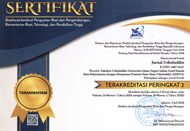The Story of Moses and Pharaoh in a Structural Anthropology Approach
Abstract
Keywords
Full Text:
PDFReferences
Ahmadi, Anas. “Symbolism of sacred and profane animals in the Quran.” Masyarakat, Kebudayaan dan Politik Vol. 33, no. Issue 1 (2020): 15–25.
Al-Qathan, Manna. Mabahis fi ‘Ulum al-Quran. Kairo: Maktabah Wahbah, 2000.
Arafat, M.Yasser. “Analisis Antropologi-struktural Kisah Musa dan Khidir dalam Al-Quran.” Al-A’raf Vol. XV, N (2018).
Bucaile, Maurice. Moses and Pharaoh in The Bible, Quran and History. Kuala Lumpur: Islamic Book Trust, 2008.
Hamka. Tafsir Al-Azhar Jilid 4. Singapura: Pustaka Nasional, n.d.
———. Tafsir Al-Azhar Jilid 4. Singapura: Pustaka Nasional, n.d.
———. Tafsir Al-Azhar Jilid 4. Singapura: Pustaka Nasional, n.d.
———. Tafsir Al-Azhar Jilid 4. Singapura: Pustaka Nasional, n.d.
———. Tafsir Al-Azhar Jilid 4. Singapura: Pustaka Nasional, n.d.
———. Tafsir Al-Azhar Jilid 4. Singapura: Pustaka Nasional, n.d.
———. Tafsir Al-Azhar Jilid 4. Singapura: Pustaka Nasional, n.d.
———. Tafsir Al-Azhar Jilid 4. Singapura: Pustaka Nasional, n.d.
———. Tafsir Al-Azhar Jilid 4. Singapura: Pustaka Nasional, n.d.
Hassanein, Hamada. “A Semiotic Analysis of Moses and Pharaoh Narrative in the Qur’an.” The American Journal of Semiotics 25.1–2 (2009): 25–88.
Kamal, Muhammad Ali Mustofa. “Masyarakat Elite dalam Al-Quran: Sebuah Pendekatan Antropologi atas Term Al-Mala’).” Jurnal Harmoni Multikultural dan Multireligius Vol.15, Ja (2016).
Lévi-Strauss, Claude. Structural Antrophology. New York: Basic Books, 1963.
———. Structural Antrophology. New York: Basic Books, 1963.
———. Structural Antrophology. New York: Basic Books, 1963.
Mawla, Ahmad jadul dan Abu al-Fadhl Ibrahim. Kisah-Kisah Al-Quran. Jakarta: Zaman, 2009.
Meeftha. “ayatalquran.net.” https://ayatalquran.net/2015/01/surah-al-araf-%D8%A7%D9%84%D8%A3%D8%B9%D8%B1%D8%A7%D9%81-the-heights-terjemah-bahasa-inggris/, 2018. https://ayatalquran.net/2015/01/surah-al-araf-الأعراف-the-heights-terjemah-bahasa-inggris/.
Mujahidin, Anwar. “Analisis Kisah Ibrahim, Musa dan Maryam dalam Tafsir Karya Mahmud Yunus, Hamka, dan M. Quraish Shihab.” Ponorogo, 2016.
———. Lokalitas Kisah Ibrahim dan Musa; antara Tafsir al-Misbah dan Tafsir al-Azhar. Yogyakarta: Pustaka Pelajar, 2019.
———. Lokalitas Kisah Ibrahim dan Musa; antara Tafsir al-Misbah dan Tafsir al-Azhar. Yogyakarta: Pustaka Pelajar, 2019.
———. Lokalitas Kisah Ibrahim dan Musa; antara Tafsir al-Misbah dan Tafsir al-Azhar. Yogyakarta: Pustaka Pelajar, 2019.
Pradoko, Susilo. “Penerapan Paradigma Strukturalisme Levi-Strauss dalam Menganalisa Fenomena Seni Pertunnjukan.” In Makalah Seminar Nasional Bahasa, Sastra, dan Seni dalam Perspektif Pluralisme Budaya, 2001.
Putra, Hedddy Shri Ahimsa. “The Living Al-Qur’an: Beberapa Perspektif Antropologi.” Walisongo Volume 20, (2012): 255–56.
Putra, Heddy Shri Ahimsa. Strukturalisme Lévi-Strauss Mitos dan Karya Sastra. Yogyakarta: Kepel Press, 2006.
———. Strukturalisme Lévi-Strauss Mitos dan Karya Sastra. Yogyakarta: Kepel Press, 2006.
———. Strukturalisme Lévi-Strauss Mitos dan Karya Sastra. Yogyakarta: Kepel Press, 2006.
Shihab, Quraish. Tafsir al-Misbah, Pesan, Kesan dan Keserasian Al-Quran Vol. 10. Jakarta: Lentera Hati, 2007.
———. Tafsir al-Misbah, Pesan, Kesan dan Keserasian Al-Quran Vol. 5. Jakarta: Lentera Hati, 2007.
———. Tafsir al-Misbah, Pesan, Kesan dan Keserasian Al-Quran Vol. 5. Jakarta: Lentera Hati, 2007.
———. Tafsir al-Misbah, Pesan, Kesan dan Keserasian Al-Quran Vol. 5. Jakarta: Lentera Hati, 2007.
Subchi, Imam. “Antropologi Al-Qur’an: Integrasi Keilmuan Kisah-Kisah Al-Qur’an dan Pokok-Pokok Antropologi Koentjaraningrat.” Ilmu Ushuluddin Volume 6, (2019).
Wheeler, Brannon M. “‘Moses.’” In The Blackwell Companion to the Qur’an, diedit oleh Andrew Rippin, 248. USA: Blakcwell Publishing, 2006.
———. “‘Moses.’” In The Blackwell Companion to the Qur’an, diedit oleh Andrew Rippin. USA: Blakcwell Publishing, 2006.
Zayd, Nasr Hamid Abu. Mafhum Al-nas: Dirasah fi “Ulum Alqur”an. Beirut: Almarkaz Althaqafi Al‘arabi, 2014.
DOI: http://dx.doi.org/10.24014/jush.v29i1.10479
Refbacks
- There are currently no refbacks.
 Jurnal Ushuluddin Indexed By:
Jurnal Ushuluddin Indexed By:
Alamat Redaksi:
 Fakultas Ushuluddin UIN SUSKA Riau Jl. H.R. Soebrantas KM. 15,5 Panam – Pekanbaru
Fakultas Ushuluddin UIN SUSKA Riau Jl. H.R. Soebrantas KM. 15,5 Panam – Pekanbaru
 E-mail: jurnal.ushuluddin@uin-suska.ac.id
E-mail: jurnal.ushuluddin@uin-suska.ac.id
ejournal: http://ejournal.uin-suska.ac.id/index.php/ushuludin

Jurnal Ushuluddin is licensed under a Lisensi Creative Commons Atribusi 4.0 Internasional.


















